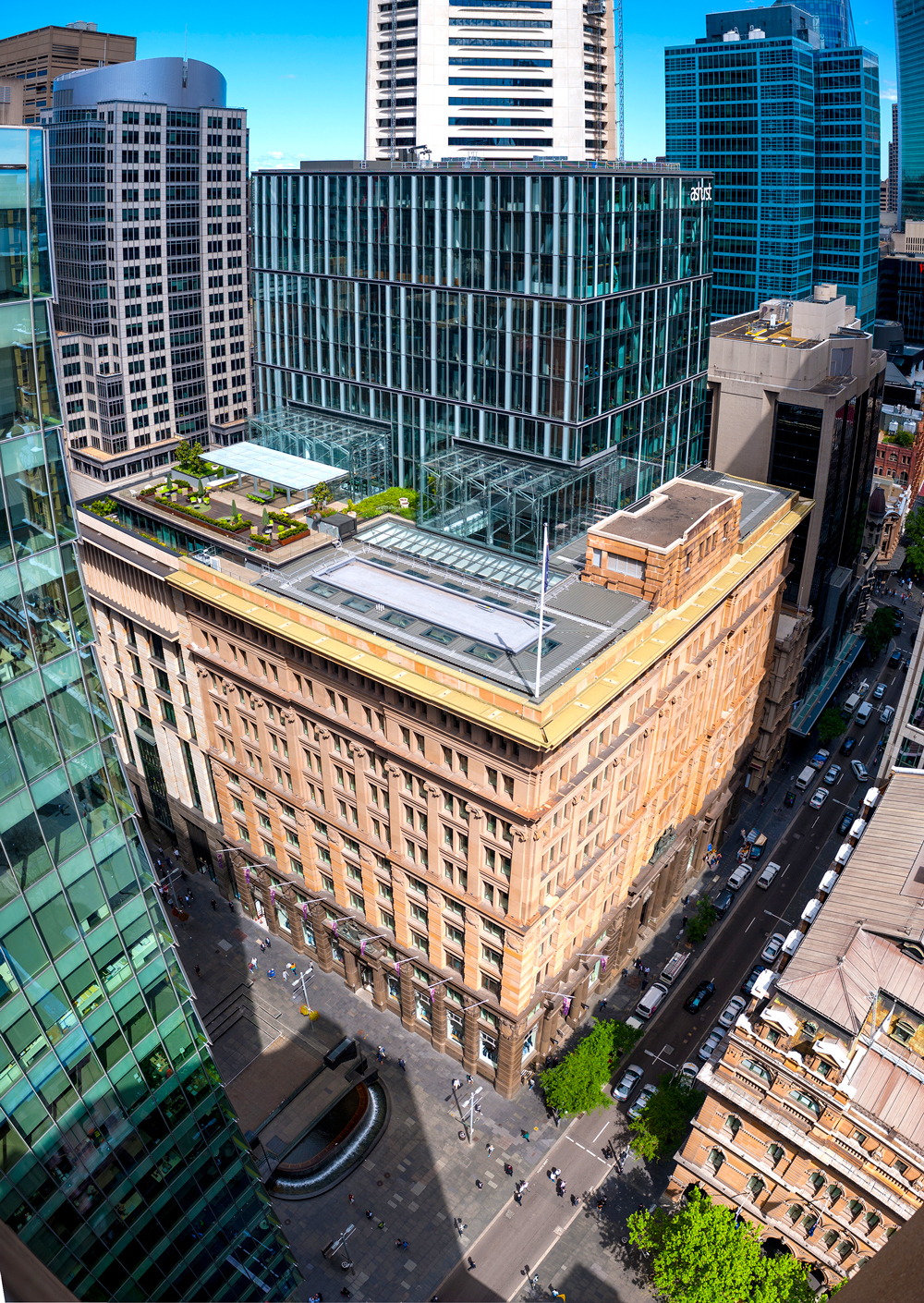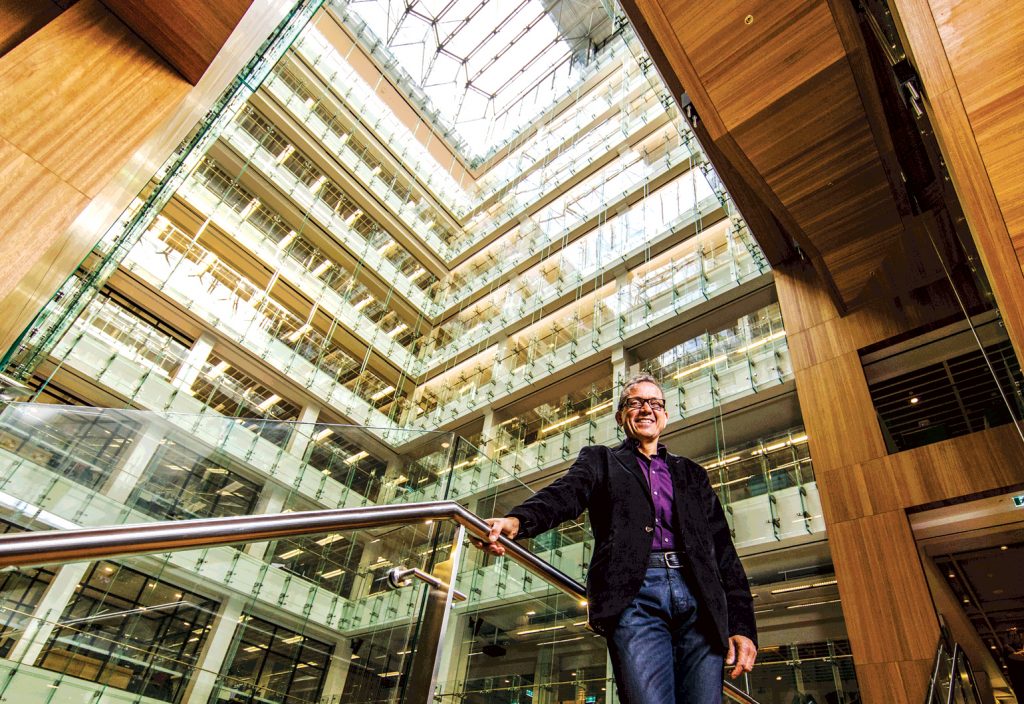While new technology and materials are creating possibilities in the world of structural engineering, Tony Lavorato says innovation comes from understanding the basics.
It’s easy to fall into the trap sometimes of thinking that a complex problem is going to need a complex solution – and sometimes it does. But the key to being innovative, according to Aurecon Design Director Tony Lavorato, is to break down the problem into its component parts and then ask the question: what if?
“It’s about having the confidence and skills to challenge preconceived ideas that allow us to create solutions that deliver amazing outcomes for clients and ultimately their end-users,” he said.

“The structural design has to be something that a designer can explain to someone very simply on a sheet of paper. Even the most complex of designs can be communicated, and if these designs are based on clearly identified and communicated structural concepts, then the design intent can be maintained throughout the engineering design and documentation and through to construction.”
He said as a design director, his role is to make sure clients can access key thinkers to get that original concept right and then ensure design integrity is maintained throughout the whole project.
“I think that’s where, as engineers, we need to really differentiate ourselves – mastering not only our technical craft but also our soft skills, such as communication and transdisciplinary thinking, and pairing this with unique approaches to design,” he said.
“We see clients coming to us at a very early stage of a project to ask us our input. In 2018, when you build in any major city in Australia, in particular my home in Sydney, there are so many constraints. Transport, constructability, existing tunnels and inground conditions, and geotechnical conditions. The method of construction to overcome these design constraints can influence the design very much. So, at that initial design stage, you need to take that into account.”
The Money Box
A recent project he highlights is in Sydney’s CBD.
On the corner of Pitt Street and Martin Place is a historic Commonwealth Bank building, affectionately referred to as the ‘Money Box’ building because its design has been used as the basis for Commonwealth Bank money boxes for almost 100 years.
Lavorato said it was originally built in 1916 with additions in 1933 and 1968, although the latter 1968 addition “wasn’t really sympathetic to the heritage nature of the site”. In the 1990s, a development application was approved to replace the 1968 addition with a tall building. This approved building was never commenced, and the development approval lapsed.
Sydney City Council placed some controls on the site, including a height limit, a setback from Martin Place, and restrictions on the 1916 and 1933 components, so they couldn’t be altered or used to support any load. The building owners were anxious to increase the net lettable area of the site and asked builder Grocon, supported by Aurecon, to investigate the idea of a cantilever structure over the old building which met all the Council conditions on the site.
“So, we had to cantilever the building some 22 m, or 11 levels, over the old Commonwealth Bank building, but couldn’t actually use the building under for any support” said Lavorato.
“The actual design concept was very simple, cantilevering the building using a strut and tie connected by nodes at top level. But the large forces that were generated created many challenges. At the intersections, or nodes, transferring the large tensile forces through the node into a strut element, resulted in large compressive forces through the nodes.”
In order to transfer these loads, he used V-shaped braces on all four sides of the tower that were incorporated into the visual design of the building. That meant they had to be designed with consideration to the aesthetics as well.
It was just as important to ensure the relationship between all the angles at the point they bisect the node were identical on all four sides of the building. This was despite the fact that the struts on the southern face meet the structure at level 14, but on the northern face they were strutted down from level 11.
To solve the main construction challenge of building this large cantilever structure, an innovative construction solution was developed with Grocon. The early stages of the cantilever section had to be built supported by hydraulic jacks located temporarily on the existing columns of the 1933 heritage building.
At a point in the assembling of the main cantilever structure when the new building could support its own weight, the jacks supporting the structure were lowered, thus ensuring the new structure was working as a cantilever.
But the act of removing these jacks would cause movement of this section as the loads were redistributed, so they had to try to predict what this movement was likely to be so that they could build it in such a way that it came out level after settling. The problem here was, while the structural design followed basic laws of physics and the loads involved were well understood, the material properties of the concrete were variable.
“In normal engineering, you look at a concrete strength, and it’s always a minimum,” he said.
“So, when you specify 40 MPa concrete, you would expect to actually get slightly higher strengths delivered. In our case, we wanted to make sure that the building deflected into a horizontal vertical alignment. So, when we’re looking at the material concrete creep properties, we’re looking at a lower bound and an upper bound. If we overpredicted the movement and released the jacks, then it would’ve been up too high. If we underpredicted, it would come down too far.”
On the day, they lowered the jacks in 5 mm increments, checking that it was deflecting at the rate expected and there were no signs of any structural problems. Finally, they could see daylight between the jacks and the underside of the cantilever and the final deflection was within a millimetre of their prediction.
“I’ve done a lot of underpinning of buildings where we remove large amounts of structure including foundations underneath buildings and hold them up while they’re constructing,” he said.
“What always amazes me is how resilient buildings are and how they seem to find a different load path. They tend to redistribute loads within its structure. So I tend to think that we overpredict the movement a little bit.”
Early career
Lavorato’s path to engineering was slightly unusual. He knew he was interested in science but wasn’t sure exactly what he wanted to do, so just enrolled in a range of first year science subjects at the University of Sydney. In his vacations, he worked on building sites as a labourer and, on one particular site at Parramatta, he found an engineer who was happy to answer all his questions about what they were doing.
“I was quite curious. Why was this reinforcement going in here? Why was that concrete being poured in that way?” he said.
“This engineer took the time to actually explain it to me when he visited the site doing inspections. He was very generous with his time, and it really encouraged me to think about structural engineering as a career.”
At the end of his degree, he was keen to stay in design rather than work directly for construction companies as a site engineer. So he got a job in the then Department of Housing and Construction, working on projects for the Department of Defence, Telstra, Reserve Bank, etc.
However, it soon became obvious this work was being outsourced to private consultants, so that’s where he turned, working first for Kinhill Engineers, then Meinhardt and, for the past seven years, Aurecon.
One of his favorite projects was one of the smallest. The University of Notre Dame was building a medical school opposite St Vincent’s Hospital in Darlinghurst. On the site was the Sacred Heart Church. Originally built in 1910, it had been expanded in the 1960s, creating a new altar, but was being reduced back to its original size.
“At the back of the 1960s expansion, there was a big concrete shell structure behind the altar with a magnificent mosaic, The Risen Christ, by Enrico Gaudenzi,” he said.
“The tiles had been formed in the Vatican Mosaic Studio in Rome and there was a great deal of heritage significance for that particular mosaic. They wanted to relocate this part of the church, including the altar, and reduce the size of the church, keeping only the altar containing the concrete shell structure and the mosaic. However, because it was on a thin shell on a curved element, we were concerned that if we lifted it and it moved even slightly there could be a loss of tiles.”
So, after a lot of research and planning, they decided to encapsulate the concrete shell, support the shell in a structural steel frame and lift the entire 93 tonnes containing the shell. On the day of the lift, a large 200 t crane was used to lift the frame and place the concrete base under tension while they cut the base with diamond saws before moving it gingerly to its new location within the old church, without the loss of a single tile.
Future challenges
Next on his plate also involves heritage considerations among detailed engineering requirements. Earlier this year, the NSW Government announced that Laing O’Rourke would undertake works at Sydney’s Central Station to build the new Sydney Metro platforms and associated infrastructure for the new metro line connecting Sydney Metro Northwest with the city and south west to Bankstown.
Aurecon and joint venture partners GHD will work with Laing O’Rourke on the project, which will include two platforms around 27 m below the current suburban platforms, and Central Walk – a new 19 m wide pedestrian concourse connecting the Sydney Metro platforms with the existing suburban platforms and Chalmers Street.
“Central Walk will need to be carefully constructed below the continuously operating suburban platforms, while minimising the disruption to the thousands of people who pass through Central every day,” he said.
“There’s heritage fabric across all of Central Station, and certainly the suburban lines have a lot of heritage structure. It also incorporates the works around the northern entrance, requiring construction around the heritage electrical building.
“When we’re creating the new entrance, protecting the heritage will be a key consideration. The Sydney Metro platforms themselves will take careful design and construction, an impressive 30 x 230 m long and 27 m below ground in the centre of the busiest operating station in Sydney.”
But challenges like these keep his job interesting.
“It’s where you make a difference that it’s most satisfying” he said, “where your design has enabled the client to create something, some value that they didn’t have at the beginning of the process.”
Tony Lavorato was one of create‘s Most Innovative Engineers in 2017. Are you an innovative engineer? Know someone who is? Register your interest for 2019 intake here.
